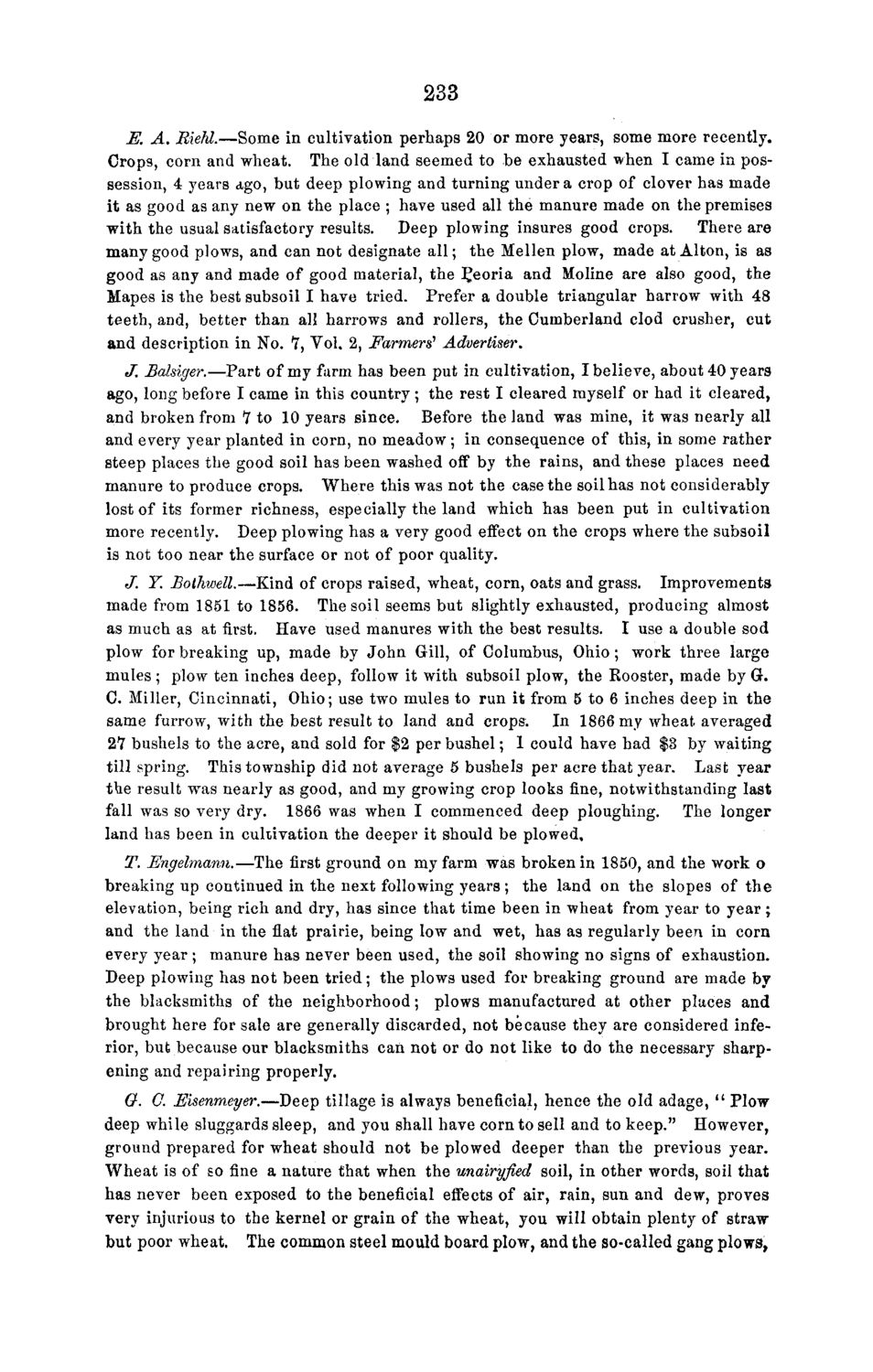| |
| |
Caption: Board of Trustees Minutes - 1868
This is a reduced-resolution page image for fast online browsing.

EXTRACTED TEXT FROM PAGE:
233 E. A. Riehl.—Some in cultivation perhaps 20 or more years, some more recently. Crops, corn and wheat. The old land seemed to be exhausted when I came in possession, 4 years ago, but deep plowing and turning under a crop of clover has made it as good as any new on the place ; have used all the manure made on the premises with the usual satisfactory results. Deep plowing insures good crops. There are many good plows, and can not designate all; the Mellen plow, made at Alton, is as good as any and made of good material, the Peoria and Moline are also good, the Mapes is the best subsoil I have tried. Prefer a double triangular harrow with 48 teeth, and, better than all harrows and rollers, the Cumberland clod crusher, cut and description in No. 7, Vol. 2, Farmers' Advertiser. J. Balsiger.—Part of my farm has been put in cultivation, I believe, about 40 years ago, long before I came in this country ; the rest I cleared myself or had it cleared, and broken from 7 to 10 years since. Before the land was mine, it was nearly all and every year planted in corn, no meadow; in consequence of this* in some rather steep places the good soil has been washed off by the rains, and these places need manure to produce crops. Where this was not the case the soil has not considerably lost of its former richness, especially the land which has been put in cultivation more recently. Deep plowing has a very good effect on the crops where the subsoil is not too near the surface or not of poor quality. J. Y. Bothwell.—Kind of crops raised, wheat, corn, oats and grass. Improvements made from 1851 to 1856. The soil seems but slightly exhausted, producing almost as much as at first. Have used manures with the best results. I use a double sod plow for breaking up, made by John Gill, of Columbus, Ohio; work three large mules ; plow ten inches deep, follow it with subsoil plow, the Booster, made by GL C. Miller, Cincinnati, Ohio; use two mules to run it from 5 to 6 inches deep in the same furrow, with the best result to land and crops. In 1866 my wheat averaged 27 bushels to the acre, and sold for $2 per bushel; 1 could have had $3 by waiting till spring. This township did not average 5 bushels per acre that year. Last year the result was nearly as good, and my growing crop looks fine, notwithstanding last fall was so very dry. 1866 was when I commenced deep ploughing. The longer land has been in cultivation the deeper it should be plowed, T. Engelmann.—The first ground on my farm was broken in 1850, and the work o breaking up continued in the next following years; the land on the slopes of the elevation, being rich and dry, has since that time been in wheat from year to year; and the land in the flat prairie, being low and wet, has as regularly been in corn every year ; manure has never been used, the soil showing no signs of exhaustion. Deep plowing has not been tried; the plows used for breaking ground are made by the blacksmiths of the neighborhood; plows manufactured at other places and brought here for sale are generally discarded, not because they are considered inferior, but because our blacksmiths can not or do not like to do the necessary sharpening and repairing properly. G. G. Eisenmeyer.—Deep tillage is always beneficial, hence the old adage, " Plow deep while sluggards sleep, and you shall have corn to sell and to keep." However, ground prepared for wheat should not be plowed deeper than the previous year. Wheat is of so fine a nature that when the unairyfied soil, in other words, soil that has never been exposed to the beneficial effects of air, rain, sun and dew, proves very injurious to the kernel or grain of the wheat, you will obtain plenty of straw but poor wheat. The common steel mould board plow, and the so-called gang plows,
| |